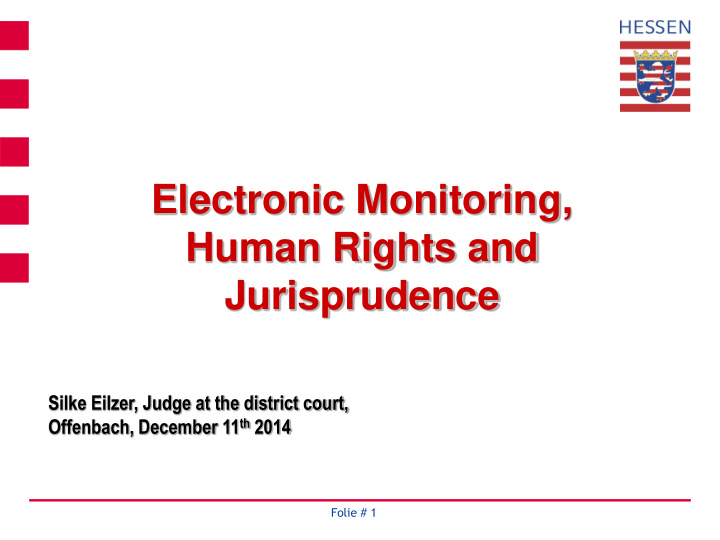



Electronic Monitoring, Human Rights and Jurisprudence Silke Eilzer, Judge at the district court, Offenbach, December 11 th 2014 Folie # 1
Great Expectations …. • Know your objective • Consent vs. Compliance • Data protection Folie # 2
Know your objective I How to avoid conflicts with the proportionality principle: 1. Be sure about your objective first 2. Than choose your technology Folie # 3
Know your objective II Three examples: • Unreliable offenders • Suspects on remand • High risk violent and sex offenders Folie # 4
Unreliable Offenders (Hessian project) Offenders, who are too unreliable to observe the conditions set by the court because they lack self discipline and motivation and are therefore not able to live a structured life are usually very difficult to handle by the probation service and the justice system. Consequently, parole will be revoked or will not be granted in the first place. Folie # 5
What do you want? 24/7 surveillance allowing an immediate reaction to breaches and close supervision by the probation service in an effort to help the participant to live a more structured life by giving him or her a daily schedule = specific times for being at or absent from home (work, therapy) or for leisure Folie # 6
The Joint Monitoring Centre receives 24/7 all events that may imply a potential dangerous situation or a violation of directions each shift consists of at least one social worker contacts the participant in order to find out the reason for the event and to de-escalate the situation if necessary informs the police reports to the supervising authority / the probation service Folie # 7
The probation service is vital to the project: recommendations to the court on the suitability of a participant within one week weekly personal contact with the participant receives reports on events by the Joint Monitoring centre on the next working day to be included in the educational work reports to the court on the development of the participant and makes recommendations Folie # 8
The Tech: Just RF, no GPS? • RF keeps it simple • Not all target groups require EM via GPS • Until 2011 no explicit mentioning of EM in the German Code of Criminal Procedure or the German Criminal Code; however, regulations have always been open to “unnamed measures” as long as they are proportionate. RF is less intrusive than GPS, so consent is sufficient and explicit legislature not necessary. Folie # 9
Suspects on remand What do you want? To reduce the flight risk compared to an obligation to register with the police Victim protection Folie # 10
The Tech: RF or GPS? GPS offers more possibilities despite its limitations than RF Hessian project: RF only, it is more focused on reducing the flight risk Folie # 11
High risk sex and violent Offenders M vs. Germany (2010): ECtHR ruling on preventive detention (application No. 19359/04) prompts the German legislator to revise the law Folie # 12
What do you want (Federal Approach)? to increase the offender‘s inhibitions to commit further crimes by increasing the risk of discovery to improve victim protection to use the data in criminal proceedings in case of relapses Folie # 13
The Tech: GPS seems to be the obvious choice Folie # 14
Consent • For all target groups? • Consent vs. Compliance • How far does consent go? Folie # 15
Consent II There is a difference between using EM • in order to avoid imprisonment and • as part of a post-release order like a supervision order Folie # 16
Supervision order? post-release court order belongs to the measures of correction and prevention like the preventive detention order or the mental hospital order may include inclusion and exclusion zones, restraining orders, ban on alcohol and drug use etc. Folie # 17
Legal Prerequisites for EM via GPS in a supervision order: the convicted person must have fully served a sentence of at least 3 years or a measure of correction and prevention must have been suspended offence listed in sec 66 of the German Criminal Code (e.g. sex offences and violent crimes) risk of re-offending with regards to the listed offences EM is necessary to prevent the offender from re-offending no unreasonable demands may be made to the lifestyle of the convicted person Folie # 18
How far does consent go? You cannot consent to everything (“Peep Show”; “Dwarf Throwing”) The more intrusive the technology, the less valid is consent as the sole legal basis Folie # 19
Right to data protection Important achievement in the context of human rights Offenders and even less suspects do not seize to have the right to it GPS is more intrusive and does not only concern offenders/suspects if there is a victim protection project where the victim is given a (removable) tracker too Folie # 20
Restrictions: Necessary but be careful not to defeat the purpose What do you think? Should the authorities be able to look at the data and the real time movements at will? Should the data be erased and if yes, when? Folie # 21
Data use and the Federal approach: Being a suspect in a criminal proceeding is not enough. The crime in question must be either a specific type of crime (sex offences, violation of exclusion and inclusion zones defined by the court in the supervision order, tampering with the EM equipment) or a crime punishable by a minimum prison sentence of one year. The data has to be erased after two months. Folie # 22
Recommend
More recommend